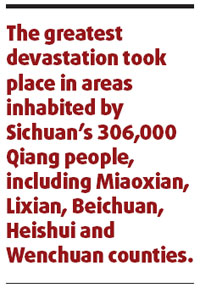Quake jeopardizes cultural heritage
(China Daily/Xinhua)
Updated: 2008-06-16 07:15
Updated: 2008-06-16 07:15
Many intangible cultural heritage relics were severely damaged by the magnitude-8.0 earthquake that jolted Sichuan province on May 12, the Ministry of Culture said on Saturday.
In Sichuan, Shaanxi and Gansu provinces, and Chongqing municipality, 14 national-level intangible cultural heritage relics were damaged; 15,009 precious items were destroyed; and 27 museums and 17 folklore villages sustained severe damage, the ministry's statistics show.
In addition, 10 State-level intangible cultural heritage promotion individuals were injured in the quake, it said.

Sichuan province suffered the greatest losses; seven of its national-level intangible cultural heritage sites were destroyed.
The quake severely jeopardized the unique intangible heritage of Beichuan, a Qiang ethnic minority autonomous county leveled by the tremor.
According to the ministry, the quake killed 25 researchers of Qiang culture, razed two intangible cultural heritage museums and seriously damaged a folklore museum.
In addition, the quake damaged many of the region's stone castles, which are unique to Qiang culture, and devastated a village famous for its Chinese New Year artworks.
The greatest devastation took place in areas inhabited by Sichuan's 306,000 Qiang people, including Miaoxian, Lixian, Beichuan, Heishui and Wenchuan counties.
The ministry is incorporating intangible cultural heritage protection into the post-quake reconstruction plan to strengthen the restoration and protection.
In addition, the ministry will send expert teams to quake-affected areas to conduct field research and develop a detailed plan to assist intangible cultural heritage carriers pass their skills on to more people.
In addition, the ministry will accelerate construction of an ecological reserve for Qiang ethnic culture.
In a related development, an exhibition on Qiang culture opened in Beijing on Saturday.
The show is part of the government's drive to raise public awareness of the need to protect minority cultures.
Staged at the Cultural Palace of Nationalities in downtown Beijing, the exhibit opened on China's third National Cultural Heritage Day and runs until June 30.
It features more than 100 depictions of the ethnic group's daily accessories and traditional garments. Photographs and videos of the Qiang people before and after the quake are also on show.
Some of the most distinctive Qiang accessories displayed include embroideries, hats shaped like monkeys' heads and sheepskin drums.
Xinhua
|
||
|
||
|
|
|
|